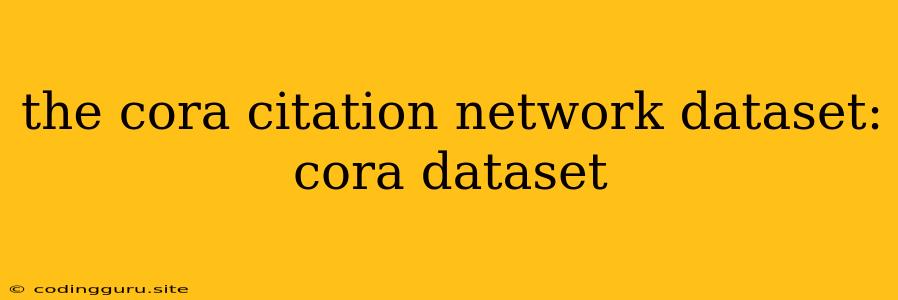The Cora Citation Network Dataset, often simply referred to as the Cora dataset, is a fundamental resource in the field of graph neural networks (GNNs) and machine learning for document classification. It offers a valuable testbed for evaluating and developing GNN models.
What is the Cora Dataset?
The Cora dataset comprises a collection of scientific publications categorized into seven distinct classes. Each publication is represented as a node in a citation network graph. The edges between nodes indicate citation relationships, meaning a directed edge points from a citing paper to a cited paper.
Why is the Cora Dataset Important?
The Cora dataset holds significance for several reasons:
- Simplicity and Accessibility: The dataset is relatively small and easy to work with, making it ideal for experimenting with GNN models.
- Structured Information: The citation network structure provides valuable contextual information about relationships between documents, allowing for effective node classification.
- Benchmarking: The Cora dataset has become a standard benchmark for evaluating GNN models. Researchers often compare their model's performance on Cora with other established approaches.
Structure of the Cora Dataset
The Cora dataset consists of:
- 2,708 Nodes: Each node represents a scientific publication.
- 5,429 Edges: These directed edges represent citation relationships between papers.
- 7 Classes: Papers are classified into seven distinct categories:
- Case-Based Reasoning
- Genetic Algorithms
- Neural Networks
- Probabilistic Methods
- Reinforcement Learning
- Rule Learning
- Theory
How to Use the Cora Dataset
The Cora dataset is widely available and can be easily accessed through various resources. Here are some steps on how to use it:
- Data Acquisition: Obtain the Cora dataset from public repositories or libraries.
- Data Preprocessing: Prepare the data for your machine learning model. This may include:
- Feature Extraction: Extract relevant features from the papers, such as word counts or TF-IDF scores.
- Graph Construction: Construct the citation network graph based on the citation relationships.
- Model Selection: Choose a GNN model suitable for node classification tasks.
- Training: Train your GNN model using the Cora dataset.
- Evaluation: Evaluate the performance of your model on the Cora dataset using metrics like accuracy and F1-score.
Examples of Using the Cora Dataset
Numerous GNN models have been developed and tested on the Cora dataset. Popular examples include:
- Graph Convolutional Networks (GCNs): GCNs use graph convolutions to aggregate information from neighboring nodes.
- Graph Attention Networks (GATs): GATs incorporate attention mechanisms to learn the importance of different neighbors.
- GraphSAGE: GraphSAGE uses an inductive approach to learn node embeddings by aggregating information from neighbors.
Tips for Working with the Cora Dataset
- Feature Engineering: Experiment with different feature extraction methods to improve the performance of your GNN models.
- Hyperparameter Tuning: Adjust hyperparameters like learning rate, dropout rate, and number of hidden layers to optimize model performance.
- Ensemble Methods: Combine multiple GNN models to improve prediction accuracy.
- Visualization: Visualize the citation network graph to understand the relationships between papers.
Conclusion
The Cora dataset is a valuable resource for developing and evaluating GNN models for document classification. Its simplicity, structured information, and widespread use as a benchmark make it a critical tool for researchers in the field. By leveraging the Cora dataset, scientists and engineers can gain insights into the potential of GNNs and contribute to the advancement of graph-based machine learning techniques.
